- En
- Fr
- عربي
Attitude towards customer relation management (CRM) and decision support system (DSS) in Lebanon
Abstract
The last few years have witnessed the growing interest in having a personalized information environment in order to deliver actionable information (having the right information, in the right format and context, and at the right time in order to make the right decisions). Today government and business are facing novel and demanding challenges. Data is growing rapidly due to diverse market forces. User populations are rising sharply to support new activities like implementing eCRM (Electronic Customer Relation Management), DSS (Decision Support System), e-Government, Mcommerce, Saas (Software-as-a-Service), DS (Digital Signatures), ERP (Enterprise Resource Planning) system, Data Warehouse on Linux, Unix, and Windows, Full Disk Encryption and Advances in Endpoint Data Security, Electronic Records Management (ERM) system, Data Governance (the formal orchestration of people, processes, and technology to enable an organization to leverage data as an enterprise asset, WebLogic Event Server, Recovery Point Objective (RPO) and Recovery Time Objective (RTO) for business, In-memory Data Grid Technologies, Content Management System, Data Grid technologies, CDP (Continuous Data Protection) and other types of Business Intelligence and self service applications. These demands not only push data scale to new data size frontiers, they also generate richer data relationships and increasingly dynamic and complex queries against them.
INTRODUCTION
To understand any complex phenomena such as implementing information and integrated statistical systems we must understand the changing environment and the future language of the e-environment. It is our opinion to be tested in this paper that rapid technological advances are expected to have significant changes in our societies and if our countries are to succeed in their efforts for advancement then, it becomes imperative for them to answer questions about the language of the future. If we ask what do we mean when we talk about implementing information and integrated statistical systems in government and corporate business? Then, we find that a mong the general public, it may remains elusive and may means buying and/ or using a specific software that deals with customer relationship and support. But still, depending on whom you ask, it can be described as ways of communicating, researching, gathering of information and using those information to interact with end users (Bourdon, 2003). Over the past few years, implementing information and integrated statistical systems have gone a long way toward implying more that just launching a technology that links the back office to the front office (Epicenter, 2003). Many researchers, including us; now agree that implementing information and integrated statistical systems means taking customers from the Zone of defection (dissatisfaction) to the zone of affection and retaining them as Apostle customers (Web-enable). If we are right, and if implementing information and integrated statistical systems actually does in part mean how to help institutions build better customer relationships and maximize a customer's lifetime value then, we are talking on how to enable government and companies to broaden their infrastructure and reach their internal and external customers through Web-based environment. It is our belief that each organization, in our digital age, should regard the globe as its prospective market and struggles to satisfy customers’ needs. Recently there has been a sudden increase in new technology-driven channels and as a result, implementing information and integrated statistical systems; emerged out of necessity to help companies track, analyze and segment customers in the e-environment (Tecnosoft, 2003). This outbreak in technology obliged senior management to have a broader understanding of skills and knowledge needed to translate technology into opportunities by means of: using existing relationships, integrating information and introducing channel processes and procedures. (Taylor et al, 2002). To this end, implement information and integrated statistical systems describes the merge of information into a single database for the purpose of customer tracking, analysis , segmentation and the purpose of improving customer continued existence. In the meantime, factors other than information such as security , trust , speed and convenience suddenly emerge to describe how to enable organizations to better understand their online customers and to create and maintain a two-way relationship in order to improve customer longevity.”(Kelley, et al, 2003).
The advantages of implementing information and integrated statistical systems are countless. People have volume of information to browse. Visitors are able to search on keywords to locate specific answers by using password and/or surfing the Web or by subscribing to a newsletter. Visitors can pursue a tour through the Web site or use a hierarchical diagram called a site map. To better serve customer’s needs. visitors can share information using face book, chat site., electronic bulletin board and script-driven forums ( Feinberg et al, 2002) at home, via phone or TV set-top box, at work via email, or on the road via WAP phone or pager (IndiaInfoline). Table I shows the difference between traditional customer service concept and implementing information and integrated statistical systems concept (Cyber futuristic):
TABLE I
The Difference Between Traditional Customer Service Concept
And Implementing Information and Integrated Statistical Systems Concept
The traditional customer service concept |
Implementing information and integrated statistical systems concept |
|---|---|
|
1. Customer has a problem with product or service late in the evening. |
1. Customer has a problem with a product or service late in the evening |
|
2. Customer has to wait till organization’s offices open the next day. He\she is upset because he cannot resolve the problem immediately |
2. Customer does not have to wait till morning to have his problem resolved. He\she visits company's website for assistance and checks the Frequently Asked Questions (FAQs). He\she is able to resolve his problem. Customer is happy |
|
3. Next day when He\she contacts the company, the Customer Service Representative assists the customer in resolving the complaint. Sometimes resolution of complaint can take days, as the Customer Service Representative may not have the desired information or necessary technical skills to resolve the problem. Customer is not happy |
3. In case, He\she is not able to resolve his problem, the customer clicks the "Need Live Help Now" button and a Customer Support Rep via web-chat greets him |
|
|
4. The Customer Support Representative accesses the knowledge base and conveys the desired information to the customer to resolve his problem. Customer is happy |
|
|
5. The details of the interaction are recorded in the customer history, so it is available to any Customer Service Representative who has any interaction with the customer in future |
|
|
6. Knowledge base is updated with relevant information from this interaction for the analysis of consumer behavior for the purpose of creating customer loyalty |
|
|
7. An email is automatically sent on behalf of the President of the company to the customer asking him if he/she was satisfied with the resolution of the problem |
The question that arises, then; is how can we implement information and integrated statistical systems in government and corporate business in Arab countries? At the basis of this is the concept of human empowerment. Implementing information and integrated statistical systems in government and corporate business is more than philosophy and technology. We believe that implementing information and integrated statistical systems in government and corporate business can be achieved by having a highly skilled applied statistician to enhance the effectiveness and efficiency of the existing database on the server in the quest to achieve a better tackling and analysis of customer behavior. e-environment has entered our market. Private as well as public institutions have their own websites and they offer around the clock the most up-to-date Services. Most banks, hotels in our countries have already offered a wide range of services through their own websites. An automatic confirmation response e-mail is sent back to customers, it responds to the customer, confirms the receipt of the e-mail, promises a swift answer back. Some hotels and airline companies offer a self checking reservation system. As a customer you are given a chance to enter your check in - check out dates. You can check the availability of the type of room you desire. You can directly check your reservation without the need to call and wait for an answer. The important thing to note here is that implementing information and integrated statistical systems in government and corporate business take more than this for the purpose of customer tracking, analysis and segmentation. It involves development and implementation of thorough cross-channel solutions including acquisition of new customers, up selling and cross selling of new products and the integration with loyalty and retention programs.” (Netways, 2003). Feinberg et all, report that “There were no significant relationships found between e-CRM features and customer traffic as measured by unique audience and audience reach. There were significant associations found between having a chat feature, having spare parts availability, gift certificate availability, having obvious mailing address, having a specific search engine for the site, other links, and a company profile on the Web site (all ps<0.05) and customer satisfaction. While these relationships cannot be considered causal their association suggests a relationship.” (Feinberg et all,2002). Finally, it is imperative to mention again that a lot of people may think that implementing information and integrated statistical systems in government and corporate business is a software that they can plug-in, turn it on, identify the most desired customers and get instant customer loyalty. implementing information and integrated statistical systems in government and corporate business is not automation of sales, service or support. In fact, implementing information and integrated statistical systems in government and corporate business cannot be purchased because it is a combination of philosophy, technology and human ability to interact with Web in determining basis of segmentation , creating lifestyle profiles and improve decision making by using the “what if” analysis of consumer behavior in the e-environment. It is our belief that human empowerment is the missing ingredient in implementing information and integrated statistical systems in government and corporate business to enhance development and advancement in our countries.
Purpose of the Study
The objective of this research is to understand users’ behavior and motives in choosing to implement information and integrated statistical systems in government and corporate business? This paper investigates both the usefulness and ease of use as they are the key elements that will affect end users intention to implement information and integrated statistical systems in government and corporate business?
Statement of the Research Problem
This paper attempts to answer this basic question: What are the direct and indirect effects of the explanatory variables to the explained variation in implementing information and integrated statistical systems in government and corporate business?
Theoretical Hypothetical Models
This thesis tests two hypothetical causal models shown below which includes all hypothesized relations to be tested. These models are based on TAM (Technology Acceptance Model) that is reported differently in previous research (Wang et al, 2003 and Nysveen et al, 2005). It is important to report here that based on data collection and data analysis, this study analyzes and reports only one of these two suggested models after modification.
Internal motives, external motives, and perceived risk affect end users intention to implement information and integrated statistical systems as shown in figure 1. On one hand, consumer behavior theory suggests that customers in their acceptance of new innovative products may have private reasons as well as social reasons (Nysveen et al, 2005). Different motives act to produce intention to implement information and integrated statistical systems. Common motives, in this paper; can be identified via Maslaw’s hierarchy of needs. Motives that produce intention to behave (adopt) may represent level two “Needs for Safety” . end users perceived ease of use may encourage or delay the intention to implement information and integrated statistical systems. At the third level, of Maslaw’s hierarchy “Needs for Belongingness”; we find end users that are motivated differently. A segment of users population may implement information and integrated statistical systems in order to satisfy level three and feel that they belong to a group who are leaders in trying new products. At the fourth level; “Needs for Self Esteem” and at the fifth level; “Needs for Self Actualization” of Maslaws’ hierarchy of needs, a segment of users population could be motivated differently in their intention to implement information and integrated statistical systems. On the other hand, Wang and his colleagues state that “According to the technology acceptance model (TAM), perceived ease of use and perceived usefulness are believed to be fundamental in determining the acceptance and use of various IT” (Wang et al, 2003). According to the technology acceptance model (TAM), it is hypothesized that perceived usefulness, perceived ease of use, and perceived credibility affects intention to implement information and integrated statistical systems.
Fig. 1 The effect of perceived risk, internal and external motives on end users intention to implement information and integrated statistical systems in government and corporate business?
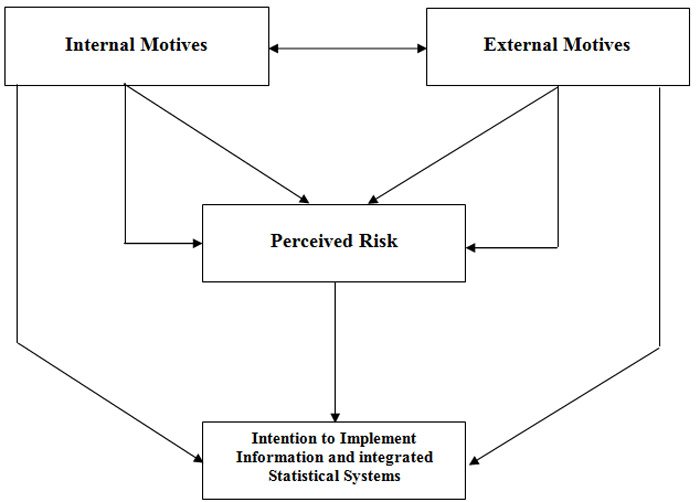
Fig. 2 The effect of perceived risk, internal and external motives on end users intention to implement information and integrated statistical systems in government and corporate business?
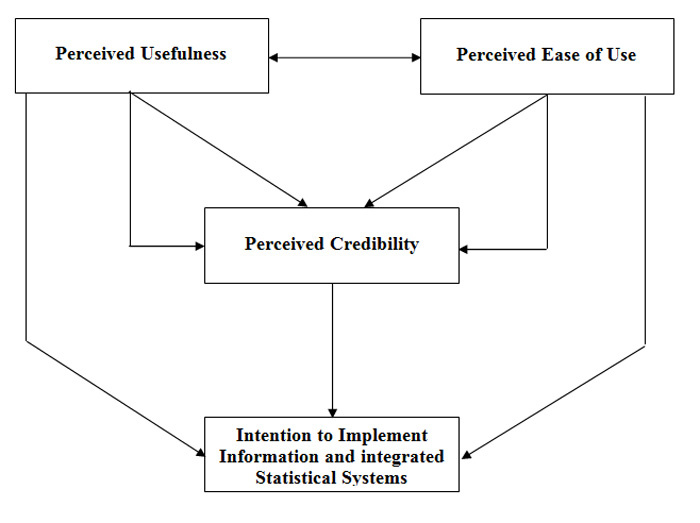
Literature Review
Based on review of literature, implementing information and integrated statistical systems in government and corporate business has gained great attention lately. The main value-adding features of implementing information and integrated statistical systems in government and corporate business include relative advantage, convenience, speed and competence. Rogers’ diffusion of innovation theory is a well known model used in explaining user acceptance of new technologies. Rogers (1962) anticipated a model of the diffusion of innovations that included five product or service characteristics assumed to affect consumer acceptance of new products and services: relative advantage, compatibility, simplicity /complexity, observability, and trialability. Relative advantage is the extent to which customers regard a new product or service as different and better from its substitutes. Compatibility is the degree to which a new product or service is reliable and compatible with customer’s beliefs, needs, values, experiences, and habits. Simplicity is the degree to which a new product or service is easy to understand or use. Observability is the degree to which a new product or service is observable and communicable to consumers. Trialability refers to customers’ competence to test a new product or service. Alavi and Joachimsthaler (1992) believed that mainly the four important characteristics that determine technology acceptance are cognitive style, personality, demographics, and user-situational variables.
Cognitive style is an expression used in cognitive psychology to explain the way people think, perceive and remember information, or their desired way of using such information to solve problems. Personality refers to the cognitive and affective structure held by persons to facilitate adjustments to events, people, and situations. Roger in 1995 stated that technology or innovation adopters are divided into five classes depending on their speed of uptake: innovators, early adopters, early majority, late majority, and laggards. Previous research has shown that implementing information and integrated statistical systems in government and corporate business provides an evidence to be beneficial to both end users and firms.
Laforet (2005) wanted to investigate the attitude of users and non users towards electronic banking with respect to technology, security, convenience, prior personal banking experience and the product attributes and reference group’s influence. The results showed that security was found to be the most important factor that motivated users adoption of online banking. Main barriers to online banking were perception of risks, computer and technological skills, and traditional cash-carry banking culture. Wan and his colleagues conducted a piece of research in 2005 on customers’ adoption of banking channels in Hong Kong; this research showed a positive relation between level of education and adoption of internet banking.
Jaruwachirathanakul and Fink researched in 2005 the internet banking adoption strategies for a developing country in the case of Thailand; this review uncovered many significant conclusions. The result of the study showed that with the exemption of the respondents' age, all moderators had a statistically significant effect on the factors impacting the adoption of internet banking in Thailand. The attitudinal factors that seem to positively influence the adoption of internet banking in Thailand most are “features of the web site” and “perceived usefulness”, while the most significant inhibiting factor to adoption is the external environment. Gan et al ( 2006) conducted research to study consumers’ choices between electronic banking and non-electronic banking in New Zealand. The dependent variable is electronic banking. The results of the study show that service quality dimensions (reliability, assurance, responsiveness) are positively related to consumer’s choice of electronic banking.
Amin conducted a research in 2007 to investigate the factors that determine the motives behind using mobile credit card among Malaysia bank customers, as their new way in carrying out payment transactions. This study verifies the suitability of the TAM in foreseeing mobile credit card acceptance in Malaysia. Perceived usefulness is significantly related to usage intentions; that means that bank costumers will make use of mobile credit card when it is useful for payment purpose. It also shows that customers may consider the issue of security and privacy before adoption.
Methodology
Population of the Study and Sample Selection
The researchers in this study did not have access to the names of the population and decided to a convenient but use a very large sample. Two thirds of the 581 respondents (64.2%) had between 5 and 20 years of experience. 55.8% of the respondents were less than 40 years old. 60.1 of the respondents have university education and below while 68% of them speak English. Only 57% of the them work for the public sector
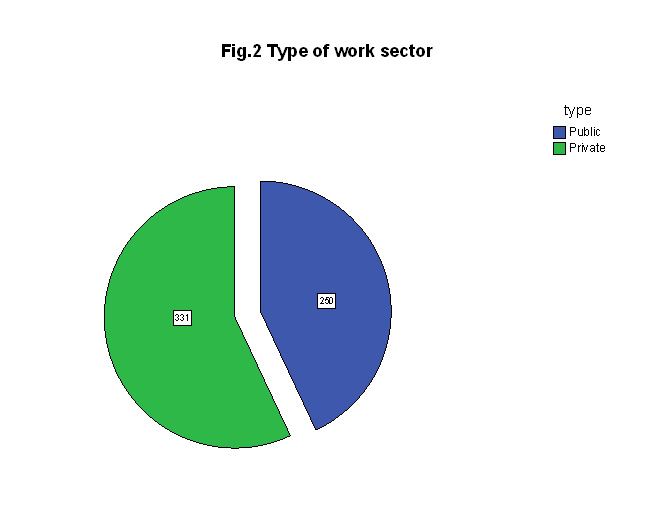
Instrumentation
Based on review of literature, discussion with experts Decision Support Systems the researchers in this thesis constructed a questionnaire using Likert type scale in which each respondent is asked to place him/ herself on a scale from 1 to 5 in which “1” means strongly disagree and “5” means strongly agree on 16 statements measuring attitude towards implementing information and integrated statistical systems. The data for this paper has been collected by means of personal interviews using questionnaire.
Relationships with Demographic Variables
Table 2 shows a relation between age and feelings toward implementing eGovernment at the 0.06 level of significance:
TABLE 2
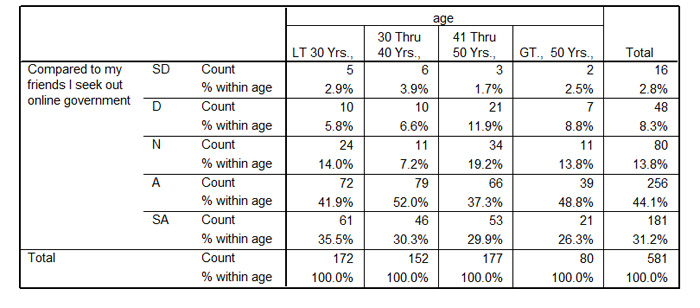
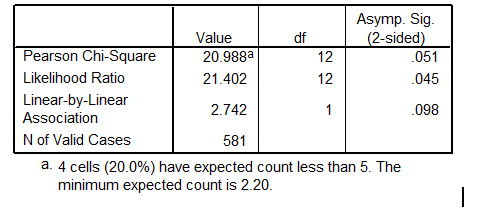
Construct Validity of the Instrument
The SPSS output shows that: the Kaisers-Meyer-Olkin (KMO) measure of sampling adequacy score of 0.796 was well above the recommended level of 0.5. Second, the Bartless test of sphericity was significant ( Chi Square = 14071.180, P = 0.000), indicating that there are adequate inter-correlations between the items which allow the use of factor analysis. Principal axis factoring was used as an extraction method and oblique rotation was used as a rotation method. Four factors were extracted using Eigenvalue greater than one criterion. The factor solution accounted for 84.301 per cent of the total variance. The factor factors were easy to label blow . The first factor accounts for 54.6 percent of total variance and is defined by eight statements with factor loadings greater than 0.70. We call factor one " Intention to implement information and integrated statistical systems ". The second factor accounts for 14.38 percent of total variance and is defined by four statements with factor loadings greater than 0.70. We call this factor "Feeling". The third factor accounts 8.617 percent of total variance and is defined by two statements with factor loadings greater than 0.70. We call factor three "Ease of use". The fourth factor accounts 6.704 percent of total variance and is defined by two statements with factor loadings greater than 0.70. We call factor four "Quality of support". As shown in TABLE 3 below:
TABLE 3
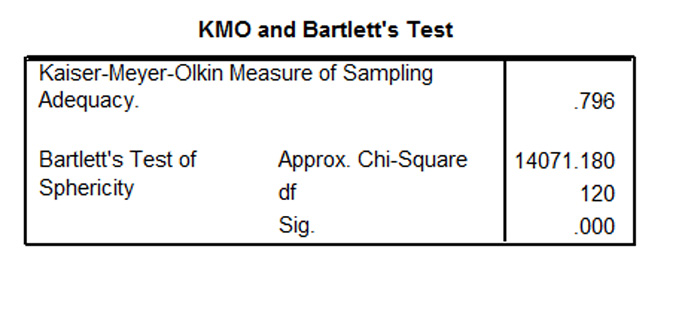
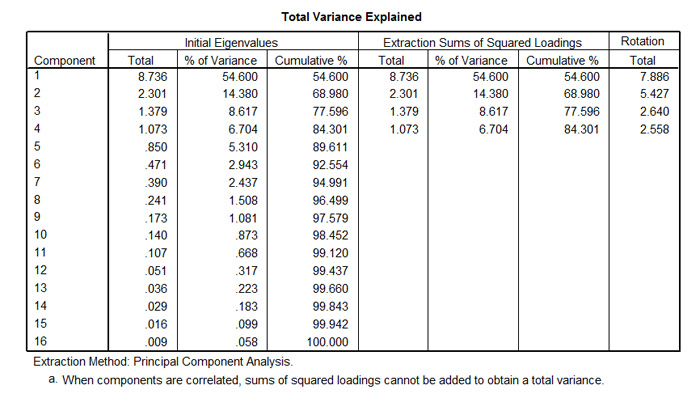
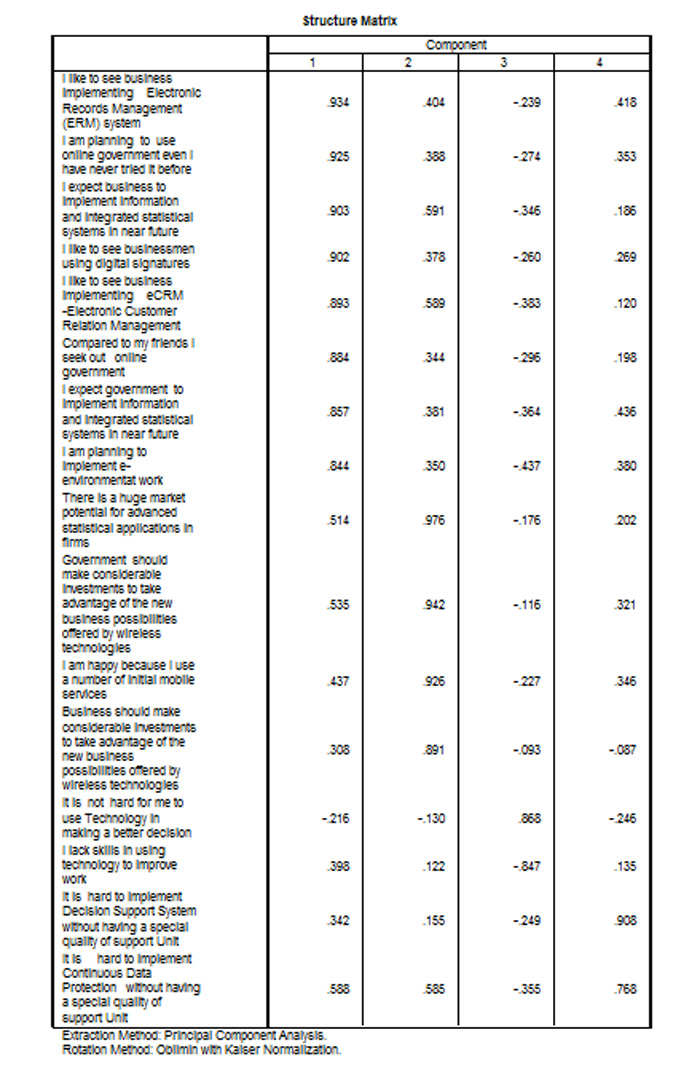
Results of Path Analysis
Fig. 3 below shows the results of path analysis. Path coefficients which measure the direct effects between variables are shown between parentheses. The highest direct effect goes from “Feelings”, the second highest direct effect goes from “Ease of use” to “Implementing information and integrated statistical systems “while the lowest direct effect goes from “quality of support”. It is very important to note here that that the direct effect of use of use on implementing information and integrated statistical systems is negative showing the more the systems are difficult then, the less the intention to implement
Fig. 3. Path Analysis Decomposing Relations into Direct and Indirect Effects
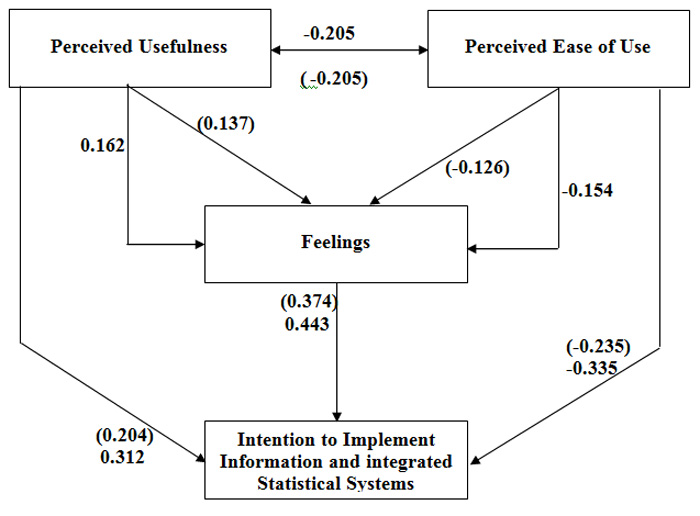
The mathematical model underlying the causal relations that lead to solving the recursive causal model are:

Let us take an example of the computation process, decompose the simple relation between “Ease of use ” and “Feelings” into “Direct Effect” and “Indirect Effect” as follows:
R31 = (-0.126) + (-0.205)(0.137)= -0.154
For policy making and for subsequent research, the results of this study suggest that the relationship between the independent variables and the dependent variable are ones of the causal sequence. Most of the relationships between variables are recommended to be further specified and clarified in subsequent research. Having negative true relations between “Ease of Use” and all other variables in the system support our belief that senior management are obliged to have a broader understanding of skills and knowledge needed to translate technology into opportunities.
Since “Intention to use ICT Systems” is related to “Perceived usefulness” and “Perceived ease of use”, and respondents feel positive about using ICT then, , it is recommended that such variables to be taken into consideration in studying of what motivate respondents to use ICT and how do they perceive using ICT is imperative. Having negative true relations between “Ease of Use” and all other variables in the system puts more responsibility on senior management in the public and private sectors to help end users adopt ICT systems.
Additional research is needed to identify the influence of security, privacy and culture over the success of ICT deployment and adoption. The findings of the study call for conducting similar studies in different countries (especially in the Arab and Gulf region) to investigate the influence of culture on the customers’ behavior and motives in choosing to adopt ICT.
References:
Bourdon Brian,(2003). “What is eCRM?” available at:
http://www.mailsbroadcast.com/ecrm.what-is-ecrm.htm
Epicenter (we deliver on our promise)
http://www.epicentertechnology.com/faqs/
Feinberg, R. A., Kadam, R. Hokama, L. and Kim, I. (2002). “The state of electronic customer relationship management in retailing”. International Journal of Retail & Distribution Management. Volume: 30 Number: 10 Page: 470 – 481. Available at:
Hitech Magazine- Lebanon
http://www.hitekmag.com.lb /ebankingpage32.htm?reload _coolmenus
Kelley, L. L; Gilbert, D. and Mannicom, R. (2003). “How e-CRM can enhance customer loyalty”. Marketing Intelligence & Planning, Volume: 21 Number: 4 Page: 239 – 248. available at:
Kumar, B. and Kumar, S. “eCRM the second paradigm shift” available at:
http://www.indiainfoline. com/bisc/nitpr06.html
Mail Broadcast by Brian Bourdon
http://www.mailsbroadcast. com/ecrm.what-is-ecrm.htm
Netways (Bring it all together)- Lebanon
http://www.netways.com.lb/ esolutions.html
Taylor, S. A. and Hunter G. L. (2002),. “The impact of loyalty with e-CRM software and e-services” . International Journal of Service Industry Management, Volume: 13 Number: 5 Page: 452 – 474. Available at:
Technosoft Information Systems Proffessionals
http://www.tecnosoft-usa .com/ecrm_solutions/ecrm_ technical_overview.asp
Web-enable (a website for stylus systems) “eCRM: Select and manage the most valuable customer relationships” available at:
تنازع المناصب والالتباس في تحديد الأدوار كعاملين في مجال تحديد عملية استبدال الموظفين
على الرغم من أن المؤسسات والأفراد يعملون في أيامنا هذه في بيئة يرتفع فيها منسوب التحديات، لا يختلف لبنان، الذي يُعتبر من البلدان النامية، عن غيره من البلدان العربية فهو ليس مندمجاً دولياً على المستويات الاقتصادية والاجتماعية والتكنولوجية والسياسية مع بقية بلدان العالم. ويمكن أن نعزو عدم ظهور لبنان في المؤشرات التكنولوجية إلى واقع أن أهم القطاعات اللبنانية هي: المصارف، معالجة الأطعمة، المجوهرات، الإسمنت، الأنسجة، المنتجات الكيميائية والمعدنية، الأخشاب والأثاث، تكرير النفط وصناعة المعادن.
ويُعدّ جزء كبير من المؤسسات اللبنانية مؤسسات عائلية تتألف من شركات صغيرة ومتوسطة، الأمر الذي يتسبب بالكثير من التعقيدات ومن ضمنها تنازع المناصب والالتباس في تحديد الأدوار والتوتر وعدم الرضى الذي يؤدي بدوره إلى استبدال الموظفين.
الموظفون والمدراء في مثل هذه الشركات هم مجرد أدوات في بنية كبيرة وهم أيضاً، في أغلب الأحيان، أول من يتم صرفهم من العمل إذا ساءت الأمور.
ويُعتبر تنازع المناصب والالتباس في تحديد الأدوار من الأسباب الرئيسة التي تدفع الموظفين إلى الاستقالة، وفي هذا الإطار أصبحت عملية استبدال الموظفين مصدر قلق كبير إذ يترتب عن ذلك خسائر مادية فادحة وإنتاجية أقل إضافة إلى انقطاع وتيرة العمل.
تحدّد هذه الدراسة الأسباب التي تدفع الموظفين إلى الاستقالة من وظائفهم وتبحث في العلاقات "السببية" بين المتغيرات المستقلة والتابعة.
وقد كان الهدف منها أيضاً تحديد "التأثيرات المباشرة وغير المباشرة لتنازع المناصب والالتباس في تحديد الأدوار على نوايا الموظفين بالاستقالة من وظائفهم ولتحديد ما إذا كان للمتغيرات النفسية والديموغرافية أي تأثير على رغبات الموظفين بالاستقالة.














